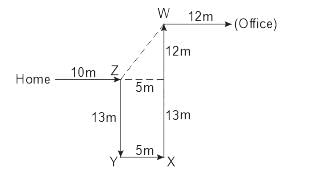JKSSB Patwari Mock Test - 7 - JKSSB Patwari MCQ
30 Questions MCQ Test JKSSB Patwari Mock Test Series 2025 - JKSSB Patwari Mock Test - 7
Who has been elected as the new Chairman of the Automotive Tyre Manufacturers' Association (ATMA)?
Buzi Bridge, which was inaugurated recently, was built by India in which country?
Who has been appointed to lead Microsoft's Windows and Surface teams?
How many seats are reserved for women in rural and urban local bodies?
What role do public facilities play in promoting national development?
Consider the following statements about tree cover in Ladakh.
- The district of Kargil is devoid of much natural vegetation and tree cover.
- Most of the tree covers of poplar and willow trees are found in Leh district.
Which of the above is correct?
Directions: In questions given below out of four alternatives, choose the one which can be substituted for the given word/sentence.
Q. The study of ancient societies.
Directions: The following question has two blanks, each blank indicating that something has been omitted. Choose the set of words for blanks that best fits in the context of the sentence.
The problem of housing shortage ______________ with the population explosion has also been ______________ by this policy.
Directions: In each of the following questions, a sentence has been given in Active (or Passive) Voice. Out of the four alternatives suggested, select the one that best expresses the same sentence in Passive/ Active Voice.
They will have completed the work by the time we get there.
The following sentence has been broken into four parts with an error in one part. Identify that part and mark it as your answer. If there are no errors in any of the given parts, mark option 4 or ‘No error’ as your answer.
Q. The student, whom you (1)/ expected to win the prize, (2)/ had lost miserably.(3)/ No error (4).
One who has little faith in human sincerity and goodness
Directions: In each of the following questions, a sentence has been given in Active (or Passive) Voice. Out of the four alternatives suggested, select the one that best expresses the same sentence in Passive/ Active Voice.
India won freedom with the blood and sweat of hundreds and thousands of Indians.
Direction: In the following questions choose the word opposite in meaning to the given word.
Meandering
Direction: A word in capital letters is followed by four words. Choose the word that is most nearly opposite in meaning to the word given in capital letters.
MANSION
Which of the following units produces a synchronization signal?
Which of the following is crucial time while accessing data on the disk?
Direction: Study the following information and answer the given questions carefully.
Kapil walks to his office. From his home, he walked 10 m towards east to reach point Z and turned right and walked 13 m to reach point Y. He took a 90 degree anticlock wise direction and covered 5 m to reach point X. Again he takes 90 degree anticlock wise direction walked 25 m to reach point W. Finally he turned to his right and walked 12 m to reach his office.
Q. What is the shortest distance between point W and point Z?



















